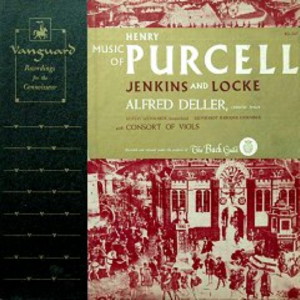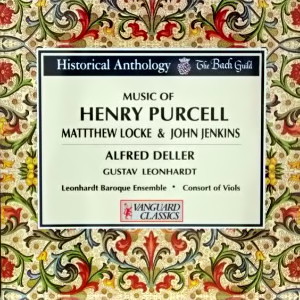 |
|
1 LP -
BG-547 - (p) 1955
|
 |
| 1 CD -
08 2029 71 - (c) 1994 |
|
| MUSIC OF HENRY
PURCELL, JENKINS AND LOCKE |
|
|
|
|
|
|
|
|
| Henry PURCELL (c.1659-1695) |
Secrecie's
song | Mystery's song - from "The
Faerie Queene"
|
counter-tenor
& ensemble
|
|
2' 58" |
A1 |
| Henry PURCELL |
Fantasia
in D for four viols, 1680 |
consort of viols
|
|
4' 03" |
A2
|
| Henry PURCELL |
"Here
let my life" - from the
Cantata "If ever I more Riches did
desire" |
counter-tenor
& ensemble |
|
2' 48" |
A3
|
| Henry PURCELL |
Prelude,
Air and Hornpipe |
harpsichord |
|
5' 31" |
A4 |
| Matthew LOCKE (death 1677) |
Fantasia,
Courante, Ayre, Sarabande |
consort of viols |
|
9' 30" |
A5
|
| Henry PURCELL |
"Here
the Deities approve" - from the Ode:
"Welcome to all the Pleasures" |
counter-tenor
& ensemble |
|
4' 38"
|
B1
|
| Henry PURCELL |
"Since
from my dear Astrea's Sight" -
from "Dioclesian" |
counter-tenor
& ensemble |
|
3' 56" |
B2
|
| Henry PURCELL |
Suite in
D minor: Allemande,
Courante, Hornpipe |
harpsichord |
|
5' 22" |
B3 |
| Henry PURCELL |
The
Plaint - from "The Faerie Queene" |
counter-tenor
& ensemble |
|
7' 25" |
B4 |
| John JENKINS (1592-1678) |
Pavane
for four viols - (Ms. source,
British Museum) |
consort of viols |
|
6' 04" |
B5 |
|
|
|
|
|
|
| Alfred
Deller, counter-tenor |
Leonhardt
Baroque Ensemble
|
Consort
of Viols
|
|
| Gustav Leonhardt,
harpsichord |
- Elizabeth
Schaftlein, recorder |
- Eduard Melkus, treble
viol |
|
|
- Gertrude Soukup,
recorder |
- Alice Hoffelner,
treble viol |
|
|
- Marie Leonhardt,
baroque violin |
- Nicolaus
Harnoncourt, bass viol |
|
|
- Nicolaus
Harnoncourt, baroque 'cello |
- Gustav Leonhardt,
bass viol |
|
|
|
|
|
Luogo
e data di registrazione |
|
Vienna (Austria) -
maggio 1954 |
|
|
Registrazione: live
/ studio |
|
studio |
|
|
Produced by |
|
Seymour Solomon
|
|
|
Engineer
|
|
Franz Plott
|
|
|
Prima Edizione LP |
|
Vanguard - The Bach
Guild | BG-547 | 1 LP - durata 52'
42" | (p) 1955
|
|
|
Edizione CD |
|
Vanguard Classics |
08 2029 71 | 1 CD - durata 52' 42"
| (c) 1994 | ADD
|
|
|
Cover Art
|
|
- |
|
|
Note |
|
Billboard, 2 July
1955
|
|
|
|
|
The
latter half of the seventeenth
century brought important
changes to English music,
changes that were to stifle
native expression for many
generations to come. Though
Puritan inhibitions were cast
aside with the accession of
Charles II, art, newly
emancipated, yielded to the
extravagance and vanities of a
sovereign who had acquired
strong French leanings.
Charles modelled his court on
that of Louis XIV; he imported
foreign musicians, created his
own Vingt-quatre violons
du Roi in which the
"vulgar" violin mingled with
the soft-spoken viol, and
introduced lavish
entertainments in the French
manner, setting the pattern
for the re-opened public
theatres where respectable old
plays were turned into
glorified musical revues.
By the turn of the century all
resistance to the flood of
foreign influence was swept
away. The venerable John
Jenkins whose chamber music
for viols had been breatly in
demand for over thirty years,
now wrote sonatas for the
violins and dance suites in
the lighter vein. Even the
conservative Matthew Locke,
"the most considerable master
of musick after Jenkins fell
off," and composer of a
"magnifick consort of four
partes after the old style
which was the last of the kind
made... conformed at last,"
says Roger North (Memoirs,
1728), "to the modes of his
time... and composed to the
semi-operas divers pieces of
vocall and instrumental
entertainment, with very good
success...". Purcell's
youthful preoccupation with
fantasias for viols (he wrote
fifteen of them in from three
to seven parts) twenty years
after Locke's "last," shows
how deeply rooted was this
traditional English form of
music-making. Although in
idiom and technique they
follow earlier works of this
genre, Purcell's fantasias are
infused with an intensity of
expression that is obiously by
the new style emanating from
Italy. His great dramatic
works were yet to come; in
these he stands alone as the
only Englishman whose creative
genius was strong enough to
meet or surpass anything that
came from the continent. Had
he lived beyond his brief
thirty-six years, the story of
English music might well have
been different.
The Restoration theatre given
a new lease on life, revived
Shakespeare, and other
renowned Elizabethans,
"adapting" them to the taste
of the time. Every opportunity
was taken to make use of song,
dance, and the elaborate
machinery of the Parisian
stage. Purcell's Faerie
Queene, based on
Shakespeare's A Midsummer
Night's Dreams, is such
an adaptation. It is a
masque-like opera and a
complete distortion of the
original play. The anonymous
librettist has rearranged
scenes, invented verses for
musical interludes and
generally altered and
disfigured Shakespear's text
so that it has become hardly
recognizable. Yet for such a
vehicle Purcell provided some
of the finest and most
effective music he ever wrote
for the theatre. The piece was
first produced in 1692. The
wit and charm of the various
spectacular and choreographic
episodes have fascinated
modern producers, who since
the rediscovery of the
manuscript in 1903 have
mounted a number of successful
revivals in England, Germany
and Belgium. An interesting
re-adaptation on the work by
Constant Lambert in
collaboration with Professor
E. J. Dent and others, was
presented with the Sadler's
Wells Ballet at Covent Garden
in 1946.
Mystery's Song and Secrecie's
Song appear seccessively
in Act II of the Faerie
Queene (Purcell Society
Edition, 1903). The former is
accompanied by 'cello and
harpsichord, the latter by two
recorders and harpsichord. The
Plaint was added to Act
V for the opera's revival in
1693. It is a song of pathos
sung over a chromatic ground
bass with a beautiful
obbligato line for violin - a
miracle of sustained
expression.
Of the four Purcell Odes
written for St. Cecilia's Day,
the earliest and one of the
best is Welcome to all the
Pleasures (1683). In the
song Here the Deities
approve which follows the
first chorus, a three measure
ground, played eighteen times,
provides a bass for the air as
well as for the long
instrumental postlude. An
arrangement of the song
appeared in the second part
of Musick's Handmaid
(1689) under the title of "A
New Ground."
Though the harpsichord solo
pieces of Purcell are not
among his important work they
are nevertheless
characteristic and individual.
The most interesting are the
little Suites published
posthumously by Mrs. Purcell
with a dedication to Princess
Anne and entitled "A Choice
Collection of Lessons for the
Harpsichord or Spinnet,"
London, 1696.
The air Here let my Life
comes from the chamber cantata
If ever I more Riches did
desire. It is scired for
violins with a continuo and is
a beatiful example of the
aptness of text and music. Since
from my Dear Astrea's Sight
was apparently written for the
revival of the opera The
Prophetess, or the History
of Dioclesian, in 1691
or 1692 and seems to have been
intended for inclusion in the
last act.
Notes
by Sydney Beck,
Music Division, New York,
Public Library
ALFRED DELLER is one of the
few contemporary masters of
the counter-tenor (pr male
alto) voice, for which Purcell
and Bach wrote some of their
most beatiful music. He is
also one of the most
distinguished modern
interpreters of Elizabethan
and Baroque music. Born at
Margate, Kent, in 1912, he won
a reputation as a boy soprano
and then moved easily into the
alto register. A favorite at
British music festivals, his
artistry has also won him
great success on the
continent, notably in the
music of Dowland, Purcell,
Handel and Bach. Of his art
the Manchester Guardian
wrote, "His production of this
unusual voice, and his
technique, are almost
flawless, and his phrasing is
unsurpassed for imagination
and sensibility." The Birmingham
Post wrote: "Mr. Deller
, whose wondrous voice graced
both Purcell and Danyel, is
one of the supreme British
singers of our generation."
Alfred Deller, who is an
exclusive Vanguard-Bach
Guild recording artist,
has also recorded ELIZABETHAN
AND JACOBEAN MUSIC, including
music by Dowland, Morley,
Bartlett, Johnson, Parsons and
Farnaby (BG-539), and J. S.
BACH: SOLO CANTATAS NO. 54 Widerstehe
doch, and NO. 170, Vergnügte
Ruh, (BG-550).
GUSTAV LEONHARDT is the
renowned Dutch harpsichordist,
organist, Baroque scholar, and
professor at the Vienna
Academy, whose harpsichord
recordings of Bach's ART PF
FUGUE (BG-532/3) and GOLDBERG
VARIATIONS (BG-536), and organ
recordings of SEVENTEENTH
CENTURY ORGAN MUSIC (BG-529)
are classics of their kind. He
performs the harpsichord solos
on this recordings.
The Leonhardt Baroque Ensemble
is made up of outstanding
musicians devoted to the study
of Renaissance and Baroque
music. On this recordings,
Elizabeth Schaftlein and
Gertrude Soukup play the
recorders, Marie Leonhardt
plays the baroque violin, and
Nicolaus Harnoncourt the
baroque 'cello. The Consort of
Viols is made up of Eduard
Melkus and Alice Hoffelner,
treble viols, and Nicolaus
Harnoncourt and Gustav
Leonhardt, bass viols.
|
  |
|
|